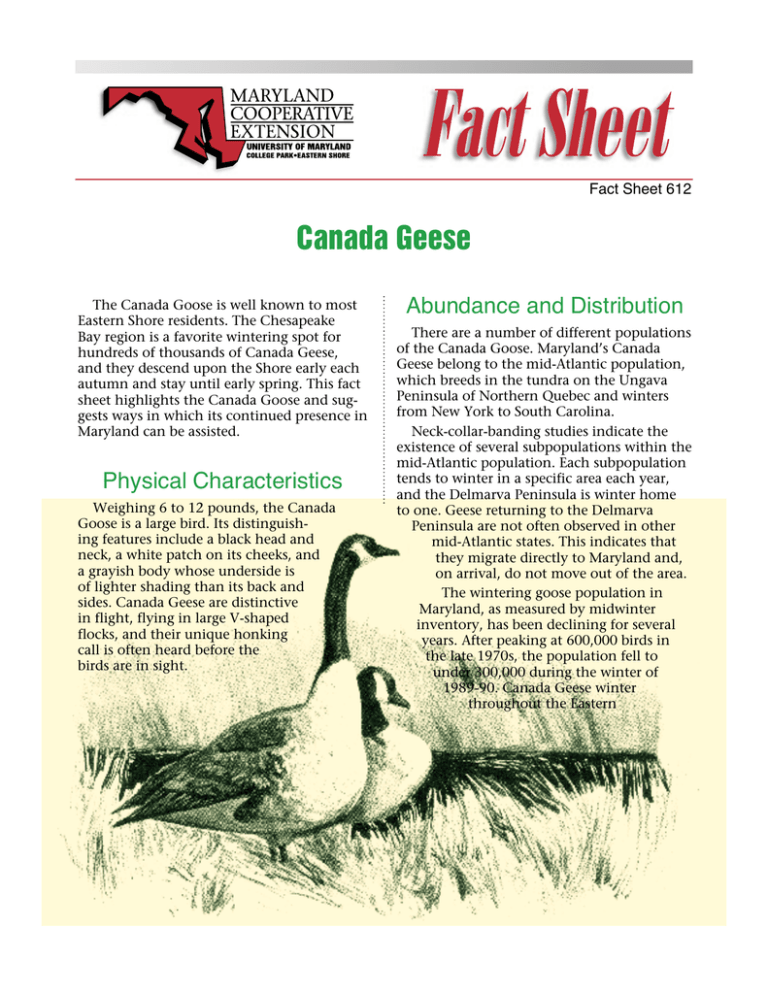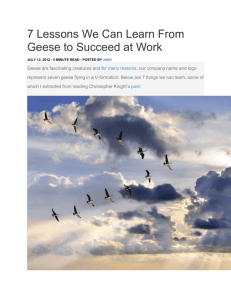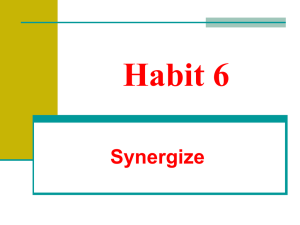Canada Geese Abundance and Distribution Fact Sheet 612
advertisement

Fact Sheet 612 Canada Geese The Canada Goose is well known to most Eastern Shore residents. The Chesapeake Bay region is a favorite wintering spot for hundreds of thousands of Canada Geese, and they descend upon the Shore early each autumn and stay until early spring. This fact sheet highlights the Canada Goose and suggests ways in which its continued presence in Maryland can be assisted. Physical Characteristics Weighing 6 to 12 pounds, the Canada Goose is a large bird. Its distinguishing features include a black head and neck, a white patch on its cheeks, and a grayish body whose underside is of lighter shading than its back and sides. Canada Geese are distinctive in flight, flying in large V-shaped flocks, and their unique honking call is often heard before the birds are in sight. Abundance and Distribution There are a number of different populations of the Canada Goose. Maryland’s Canada Geese belong to the mid-Atlantic population, which breeds in the tundra on the Ungava Peninsula of Northern Quebec and winters from New York to South Carolina. Neck-collar-banding studies indicate the existence of several subpopulations within the mid-Atlantic population. Each subpopulation tends to winter in a specific area each year, and the Delmarva Peninsula is winter home to one. Geese returning to the Delmarva Peninsula are not often observed in other mid-Atlantic states. This indicates that they migrate directly to Maryland and, on arrival, do not move out of the area. The wintering goose population in Maryland, as measured by midwinter inventory, has been declining for several years. After peaking at 600,000 birds in the late 1970s, the population fell to under 300,000 during the winter of 1989-90. Canada Geese winter throughout the Eastern Nesting Shore, but the greatest numbers are found in Kent County (about 140,000), probably because of the number of large farms that grow corn crops and the existence of many protected roosting ponds. Fewer geese winter in Cecil, Queen Anne’s, and Talbot counties (about 40,000 each), and fewer still winter in Dorchester County, where less than 30,000 geese arrive each year. Caroline, Somerset, Wicomico, and Worcester counties winter fewer geese than other Eastern Shore counties, generally with only 1,000 to 3,000 geese wintering in each. Canada Geese begin arriving on the Eastern Shore during late September and remain until February or March when they begin their northward migration to the breeding grounds. Their numbers peak most often during November. Of the 10,000 permanent-resident Canada Geese in Maryland, 2,500 live on the Eastern Shore. In recent years, a population of “resident” Canada Geese has risen in Maryland. These birds do not migrate north but remain in Maryland year-round both to breed and to winter. A breeding waterfowl survey conducted by the Maryland Department of Natural Resources in 2002 estimated that 36,600 Canada Goose pairs breed in Maryland. Although nesting begins soon after arriving on the northern breeding grounds, nest initiation is highly dependent upon the weather. Late springs on the tundra delay the nesting season and hamper nesting success. Average clutch size for the Canada Goose is four to seven eggs. Incubation lasts from 25 to 30 days. Nest failures are caused by a variety of factors, including predation, flooding, severe weather, or desertion by the adults as a result of disturbance. Once hatched, the young gosling cannot fly until it is about 60 days old. During this rearing period, the adult undergoes a wing molt to replace worn flight feathers and, like its young, is flightless. The adult regains flight at about the same time that its young are ready to fly. Habitat For its winter habitat, the Canada Goose needs open-water roosting areas and large fields or wetlands for feeding. Roosting sites can be large ponds, lakes, or rivers that are protected from severe weather. Frequent disturbances from hunting or other activities cause the goose to abandon its roost and use another site. Life History of Canada Geese The Canada Goose is slow to reach sexual maturity. While some females breed at 2 years old, most are not highly productive until they become 4 or 5 years old. They normally form pair bonds on the wintering grounds; however, some younger birds may not pair until reaching the northern breeding area in early spring. Once paired, the birds are mated for life; if a mate dies, however, the surviving bird finds a new mate. Table 1 outlines other life history characteristics of Canada Geese. 2 Table 1. Life history of Canada geese. Mating Pairs mate for life. Most breeding occurs on Northern Canadian tundra during early spring, although a growing number of birds have become year-round residents and breed on the Eastern Shore between March and May. Breeding starts after they are at least 2 years old. Many do not breed until they are 3 years old or older. Older birds are usually more successful breeders. Clutch size 4 to 8 eggs Incubation 25 to 30 days Hatching April to May Brood size 3 to 6 goslings. After several weeks of brood rearing, it is frequently observed that a number of broods will band together and form a single, large brood of up to 20 goslings. Age to flight 60 days. Adults molt worn flight feathers during brood rearing and are also flightless until the young are ready to fly. Adult plumage The adult bird has a grayish body with undersides a lighter shade than its back and sides. It has a black head and neck with a distinguishing white patch on its cheeks. Weight 6 to 12 pounds Home range The Mid-Atlantic population, to which Maryland’s Canada geese belong, summers on the Ungava Peninsula in Northern Quebec and winters in the mid-Atlantic region from New York to South Carolina. The Delmarva Peninsula subpopulation returns to the Eastern Shore each year and rarely strays from the region. Mortality The primary cause of death on the wintering grounds is hunting by humans. Disease, lead poisoning, and malnutrition can also be significant mortality factors. Food marshes, it frequently feeds on seeds of sedges, millets, bulrushes, and other wetland vegetation. Roots and rhizomes of several species of scirpus are also an important food source, especially later in the wintering period. It is not known, however, if the goose actually prefers this food source or if it is just using it because most other food sources have been depleted by late winter. The Canada Goose is both a grazer and a seed eater. Before the advent of extensive agricultural practices, it fed primarily on seeds and vegetation found in natural wetland areas. At present, it has a preference for and makes extensive use of waste grain in cultivated fields, especially harvested cornfields. Larger fields are preferred by the goose because potential predators can be seen at greater distances. Small fields surrounded by dense cover or forested habitat are less preferred. The Canada Goose also frequently grazes on green forage crops, such as clovers, ryegrass, orchard grass, and winter wheat. Green forage crops are preferred over other crops when the goose first arrives at its wintering grounds. Wetland habitats are also important to the Canada Goose as feeding areas. Within A potentially critical habitat component is the availability of grit. Grit is especially important to the goose when it is feeding on hard seeds because grit is required to help the gizzard grind up food. Grit is often obtained during the course of normal feeding activities. However, if fields or wetlands do not provide grit particles of proper size, the goose may seek out areas where it can obtain this important dietary component. 3 Mortality Factors impoundments where water levels can be lowered during the growing season to allow for plant growth. Draining these areas from late May through June and maintaining the soil as a moist mudflat will produce the best results for geese. Among the desirable vegetation produced under this management regimen are various species of cyperus, smartweeds, panicums, and wild millets. To make these food resources available to waterfowl, the area will need to be reflooded with 6 to 10 inches of water as the geese arrive in the fall. On its wintering grounds, the Canada Goose has few natural predators other than humans. Eagles or other predators occasionally feed on geese, most often on those already sick or injured. Hunting accounts for 80 to 90 percent of Maryland’s Canada Goose mortality. The Canada Goose, like other waterfowl species, is susceptible to a variety of diseases, including Newcastle disease, duck plague, avian cholera, and aspergillosis. Lead poisoning from ingestion of spent shot may also cause significant mortality. Conditions for significant outbreaks of disease occur during winter when the goose population is concentrated in small areas and is under stress from severe weather and a scarcity of food. Canada Geese on the Eastern Shore rely primarily on agricultural fields for food. Various agricultural practices affect the quantity of food available to geese during the critical wintering period. A farm also managed for Canada Geese may pursue several strategies that can enhance its attractiveness to the birds. Management Canada Goose habitat management on the Eastern Shore is oriented toward the provision of adequate wintering habitat. Winter can be a very stressful period for waterfowl because of extreme cold and difficulties in locating sufficient food. During this period, it may lose a significant portion of its body weight, increasing its vulnerability to predators, disease, or starvation. The condition or nutritional status of a goose during winter also may affect how successful it is at reproducing the following spring. It relies heavily on stored body reserves for egg production and health maintenance during the breeding season. Body reserves are obtained either on the wintering grounds or on stopovers during the northward migration. It is, therefore, important to provide highquality habitat during the wintering period. The two primary habitat needs—roosting sites and feeding areas—should be located as close to each other as possible. Flight is a costly metabolic activity, burning a lot of energy; long-distance feeding flights may burn up more energy than is taken in during feeding. Frequent disturbances on feeding fields or poor-quality food resources may also affect this energy expenditure-intake ratio. The Canada Goose feeds in either marsh wetlands or agricultural fields. In wetland areas, most food is produced on managed Field Characteristics The larger the field, the more attractive it will be to feeding geese. An exact minimum field size cannot be provided because this is highly dependent upon the type of habitat around the field. Fields as small as 5 acres may be well used by geese if the adjoining area is a pond or other open habitat. If a field is surrounded on all sides by tall forests, it may need to be 50 acres or more before the geese will use it frequently. Crop Preferences Canada Geese will feed on a variety of crops throughout the winter; however, they will 4 which the geese prefer over soybeans. This practice also can increase the frequency of feeding on other crops, including corn, sorghum, and buckwheat. Crop Management A number of factors affect availability of a crop to Canada Geese. Unharvested row crops are usually unavailable to the birds. This is because of their strong preference to feed in open habitats where they can easily observe potential predators. Harvesting or knocking down the crop is required if the geese are to accept it. They will use standing, unharvested corn or sorghum on occasion but only when they are under severe stress from cold weather, when snow covers most other food sources, or when the field is flooded with water. Standing corn or sorghum can be made more accessible and attractive by several methods, such as harvesting strips of corn throughout a field, flooding it with water, or planting at the edge of a large water area where the geese can easily work up into the edges of the field. Fall harvest and planting practices also strongly affect availability of waste grain, especially that of corn crops. Early season corn harvesting frequently allows waste corn to germinate and sprout before the geese arrive for the winter. When this occurs, these fields are essentially lost as feeding habitat. It is, therefore, recommended to delay harvest as long as possible if goose habitat is an objective for the field. Another farming practice that greatly reduces the quantity of food available in fields is fall tillage and planting of winter wheat crops. select those food items that fulfill specific dietary needs influenced by time of year or weather conditions. Upon arrival at the wintering grounds in late September or October, they prefer high-protein foods, such as buckwheat and various clovers. At this time of year, protein is required by the still-growing juvenile birds. Not all clovers are preferred by the geese, however. Observations from the Blackwater National Wildlife Refuge noted that while ladino clover was eaten extensively, red clover in adjoining fields seldom was eaten. As winter progresses and it becomes colder, the Canada Geese seem to prefer “hot foods”—those high in carbohydrates, such as corn and sorghum. When these foods are abundant and easily accessible, the geese can obtain sufficient quantities of high-energy food to maintain body warmth with minimum energy expenditure. Soybeans are not a crop preferred by Canada Geese, but they will feed on them extensively when other crops are covered with snow or have been depleted. The frequency of geese feeding in harvested soybean fields could be significantly increased by planting a fall cover crop of annual ryegrass, Habitat Management In addition to a diverse feeding habitat, Canada Geese also require safe roosting and loafing areas. This requirement is generally fulfilled by large open-water areas of major rivers and coves along the Chesapeake, or by small ponds and lakes. 5 Manipulation of crops during hunting season is controlled by law. Please check with your local Department of Natural Resources Law Enforcement office before undertaking this practice. Adapted from: Quality roosting ponds should be at least 3 acres in size with gradual side slopes so that birds may easily walk up onto the shoreline to loaf during midday. The shape of the pond is not very important; however, an irregularshaped pond provides leeward areas where birds can rest out of the wind. Vegetation on at least a portion of the pond’s perimeter should be low and sparse to allow for daytime loafing along the shoreline. The remaining pond perimeter may have brush or forested habitat along its edge to provide additional protection from strong winds. Roosting ponds should be maintained as disturbance-free as possible; otherwise, the pond may be abandoned for another site. Provision of high-quality wintering habitat is critical to the Eastern Shore’s Canada Goose population. Winter is a very stressful period for wildlife, and when they spend long periods in poor habitat, their body condition becomes weakened. It is important to realize that if the birds return to their breeding ground from their wintering areas in good condition, the probability of a successful nesting season is greatly increased. Bellerose, F.C. 1976. Ducks, Geese, and Swans of North America. Stackpole Books; Harrisburg, PA. Harvey, W. 1987. “Winter Movements and Resource Use by Canada Geese Affiliated with Kent County, Maryland.” M.S. Thesis. Cornell University; Ithaca, NY. Malecki, R.A., S.E. Sheaffer, and J.W. Enck. 1988. “Influence of Agricultural Land Use Changes on Wintering Canada Geese in the Atlantic Flyway.” Trans. N.E. Section Wildlife Society 45:8-17. Reviewed by: Robert L. Tjaden Assistant Director Agriculture and Natural Resources University of Maryland, College Park Funded in cooperation with the Maryland Department of Natural Resources and the U.S. Fish and Wildlife Service. 6 This Wildlife Management series was published by Maryland Cooperative Extension with joint expertise and funding from the U.S. Fish and Wildlife Service and the Department of Natural Resources. Marylanders interested in wildlife management can refer to this series for basic wildlife management concepts, species’ needs, management recommendations, habitat requirements, food and cover plants, and other general considerations. Contact your county Extension office for more information on wildlife management. Fact sheet titles in the full series are: Fact Sheet 597 Introduction to Wildlife Management Fact Sheet 598 Planting Crops for Wildlife Fact Sheet 599 Brush Piles for Wildlife Fact Sheet 600 Field Border Management Fact Sheet 601 Eastern Cottontail Rabbits Fact Sheet 602 Bobwhite Quail Fact Sheet 603 Ring-necked Pheasants Fact Sheet 604 Ruffed Grouse Fact Sheet 605 Mourning Doves Fact Sheet 606 Eastern Wild Turkeys Fact Sheet 607 Tree Squirrels Fact Sheet 608 Black Bears Fact Sheet 609 Wood Ducks Fact Sheet 610 Dabbling Ducks Fact Sheet 611 Diving Ducks Fact Sheet 612 Canada Geese Fact Sheet 613 Songbirds 7 Canada Geese by Harold Laskowski Wildlife Biologist Blackwater National Wildlife Refuge Cambridge, Maryland Issued in furtherance of Cooperative Extension work, acts of May 8 and June 30, 1914, in cooperation with the U.S. Department of Agriculture, University of Maryland, College Park, and local governments. Thomas A. Fretz, Director of Maryland Cooperative Extension, University of Maryland. The University of Maryland is equal opportunity. The University’s policies, programs, and activities are in conformance with pertinent Federal and State laws and regulations on nondiscrimination regarding race, color, religion, age, national origin, gender, sexual orientation, marital or parental status, or disability. Inquiries regarding compliance with Title VI of the Civil Rights Act of 1964, as amended; Title IX of the Educational Amendments; Section 504 of the Rehabilitation Act of 1973; and the Americans With Disabilities Act of 1990; or related legal requirements should be directed to the Director of Human Resources Management, Office of the Dean, College of Agriculture and Natural Resources, Symons Hall, College Park, MD 20742. P2003 8




